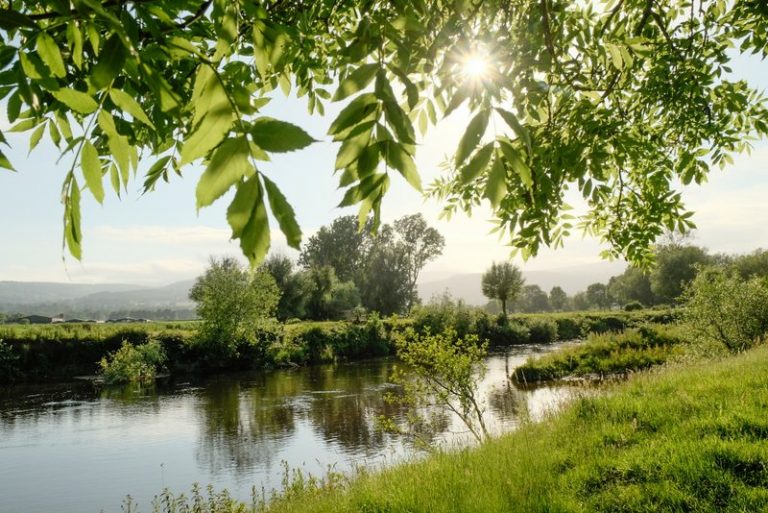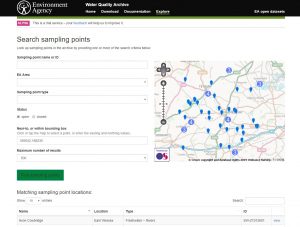
A new campaign from The Rivers Trust show the location of all sewage outflows, including ‘CSOs’ which should only discharge during periods of exceptionally high rain. Open the map to check out your local stretch of rover to see where sewage discharges are, and how often CSO tend to discharge, in their new river water quality interactive map. You can read more about the issue of CSOs in The Guardian here.
You can also read more about wild swimming risks and safety here.
Also the Environment Agency have a basic facility for checking historical water quality (from sampling data over previous months and years, and although not ‘real time’) this can give a good indication of usual water quality, but does not test for bacteria such as E Coli. Head to the Environment Agency’s water quality map .

Navigate into the map (by using the arrow keys, dragging the map or zooming in and out), then click in the fourth box down
Near-to, or within bounding
and then onto the map, to collect the grid ref
and then the big green button’,
find sampling sites.
Blue dots appears if there are sampling sites, with a list below too.
Sometimes the results will be for a tributary of the river, not the whole river. Often the test will be done at the junction of two rivers. Data is provided for:
* Chemistry (A-F)
* Biology (A-F)
* Phosphates (1-6)
* Nitrates (1-6)
* Year of sampling
A or 1 is the best, F or 6 the worst.
 Nitrates and Phosphates are not poisonsous but they can make the river green (eutrophication).
Nitrates and Phosphates are not poisonsous but they can make the river green (eutrophication).
You should not swim in a river with a Biological or Chemical rating of D, E or F.
You should exercise caution in a river of level C by covering cuts with a plaster and trying to keep your head above water.
A and B are good or very good water quality rivers – enjoy!
Water Quality and Ecology
Our rivers and lakes are cleaner today than in the 1950s and 1960s when industrial and agricultural pollution almost succeeded in killing our rivers. In the 1960s but the success of the 1974 Control of Pollution Act and subsequent European legislation has been remarkable.
The Environment Agency monitors all our rivers, streams and lakes regularly at over 7,000 locations. River quality targets are assigned based on biological, chemical and nutrient testing. Over 70 per cent of the rivers of England and Wales are very good (target 1 or A) or good (target 2 or B) on a five-tier water quality scale.
Most people’s first concern is usually sewage but with the new European Water Framework Directive in place all effluent now undergoes at least two treatments before entering a river and, increasingly, a third to make it completely sterile and pure. Any bacteria that do remain are quickly killed by the sun’s UV rays, or eaten up in the micro-foodchain of the river so, the further downstream of the treatment works you are, the cleaner the water will become. Treatment sites are indicated on OS maps as a little cluster of four or six circles by rivers near towns.
Health risks
Blue–green algae – In lowland lake swimming, after warm, wet weather, usually in late summer, algae can multiply and a powdery, green scum (the blooms) can collect on the downwind side of a lake. It’s obvious and unpleasant and can give you a skin rash or irritate your eyes if you bathe in it, and make you sick if you swallow it. Find a part of the lake without blooms or go somewhere else.
‘Swimmer’s itch’ (cercarial dermatitis) can be caught from contact with little snails that live on the reeds around marshy lakes and stagnant ponds. It creates a temporary but sometimes intense itching sensation that can last for up to two days. It’s not common, and requires no treatment, but it’s best to avoid wallowing in the bogs when outdoor swimming!
Weil’s disease – In urban areas sewers and storm drains may harbour colonies of rats whose urine may carry the bacterial infection Leptospirosis. Never swim in urban rivers, particularly canals, and be particularly cautious after heavy rains. None of the locations in this book carry any significant risk but if you are concerned about water quality cover any open wound with a waterproof plaster and keep your head (eyes, nose and throat) out of the water as much as possible. If you get flu or jaundice-like symptoms three to fourteen days after swimming in high risk water ask your doctor for a Leptospirosis test. It is simply treated with antibiotics but if left it can develop into the more serious Weil’s disease, which has been known to kill.
Trackbacks For This Post
1 review
[…] Wild Swimming Quick Guide to Water Quality explains that Grade A and B water is fine to swim in and that high levels of nitrates and […]
-Thanks for this good sharing I love all ideas and apply these within proper time. We know that funky trunks water quality has much importance. These all ingredients are useful for water best quality. So before jumping in water first check the quality otherwise takes help from swimming schools.
-Many of people don’t know about swimming water quality but after reading of this blog they all of known as better. Now people will easily to select or choose that which swimming school is suitable for swim regarding swim water. Thanks for sharing. Now i am easily to search swim school for my younger baby which is suitable for her swim learning
-Your Comments



















[…] Wild Swimming Quick Guide to Water Quality explains that Grade A and B water is fine to swim in and that high levels of nitrates and […]